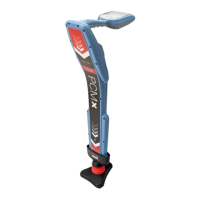14 15
ENGLISH
PCMx transmitter
signal connection
WARNING! Appropriate safety
procedures must be followed before
removing pipeline CP connection from
the rectier. Before handling connection
leads switch both the rectier and PCMx
transmitter OFF.
Connection to a rectier
A rectier station is an ideal place to
connect the output of a PCMx transmitter
as it provides connections to both pipe
and an anode bed for a suitable ground.
The rectier can also be used to power
transmitter using the mains supply. The
Tx-150PCM can also be powered from
the rectier output.
1. Disconnect both pipe and anode
cables from the rectier.
2. Ensure the transmitter is turned off.
3. Connect the White signal output lead
to the pipe cable.
4. Connect the Green signal output lead
to the anode cable.
When connection to a
rectier is not possible
Connection of a PCMx transmitter can be
made to a suitable test point or directly
to the pipeline itself. Connect the White
output cable to the connection that is
connected directly to the pipeline and
connect the Green output lead to either
a sacricial anode or use a suitable earth
stake.
If using a sacricial anode, make sure
that it is not directly connected to the
pipeline. When using an earth stake,
position the stake 45m / 150 feet away
from the pipe. To achieve a suitable
earth, it may be necessary to use more
than one earth stake linked together.
When connecting to an electrical
isolation joint, you may connect the
White lead to one side of the joint and
the Green output lead to the opposite
side of the pipe section as this can often
provide a suitable ground connection.
Conducting a
pipeline survey
Locate and pinpoint the pipe
0
V
Insulating
Joint
Anode
Rectifier
(Disconnected)
Mains
Supply
PCM Tx
+
A
I
is indicated by a rising bar graph and
an increase in tone when volume is
switched on.
Pinpointing denes the exact position
and direction of a pipeline after its
position is approximately known.
Pinpointing is important as the depth
and current readings are affected by
misalignment errors.
1. Adjust the receiver sensitivity to
approximately 50% by pressing
the
and
keys. This enables
changes in the bar graph to be more
readily seen.
2. Hold the PCMx upright and near to
the ground.
3. Move it slowly from side to side
and dene the point of maximum
response by looking at the bar graph.
The guide arrows should be at
minimum length.
4. To align the PCMx with the pipeline,
rotate the receiver until the compass
is in the 6 O’clock position.
The PCMx receiver features TruDepth
™
, a
feature that helps to ensure the accuracy
of locate or survey measurements. When
the receiver is not aligned correctly with
the pipe direction, the depth and current
measurements are automatically removed
from the display. The measurements
will also be removed when the receiver
determines that signal conditions are too
poor for reliable results.
Having pinpointed the pipe, the PCMx will
display the depth of the pipe, (measured to
the center of the pipe), and the current of
the locate signal. It is now possible, using
the guide arrows, to follow the pipeline.
C
A
A B
C
B
With the magnetometer foot attached,
switch on the PCMx receiver.
1. Use the
key to match the frequency
mode of the receiver to the operating
frequency of the transmitter. If you
intend to conduct a survey of the
pipeline, ensure both transmitter and
receiver are set to one of the mapping
frequencies, (ELF, ELCD or LFCD).
2. If you wish to capture location ensure
the internal GPS is switched on (see
details below).
3. Set the antenna mode to Peak+
by pressing the antenna key
.
The screen will display
Once in
Peak+, holding down the antenna
key alternates between adding
Guidance or Null modes to the Peak
reading. Add Guidance mode, by
holding the antenna key down; Guide
appears in the lower left corner of the
display. Two holds may be required
depending on the starting mode.
4. Use map information or pipeline
markers to determine an approximate
location for the pipe. Holding the
PCMx receiver upright at your side,
follow the guidance arrow to cross the
path of the pipe. Proximity to the pipe

